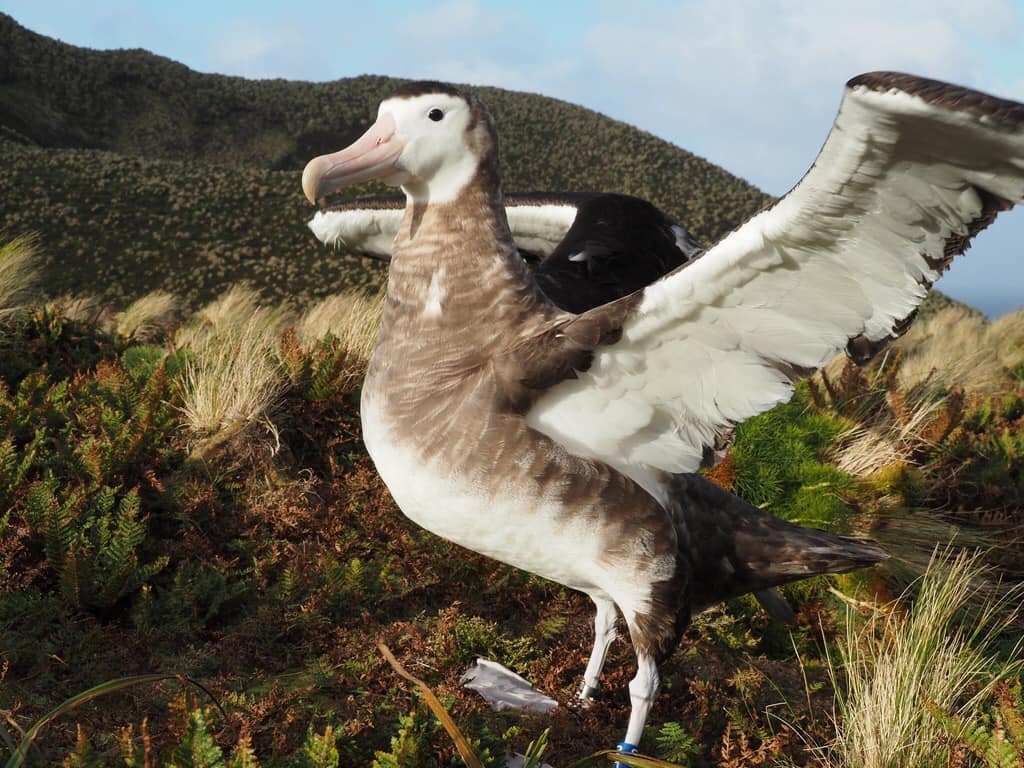
Kath Walker presenting at the 2024 Birds New Zealand Annual Conference
At the recent 2024 Birds New Zealand Annual Conference held in Nelson, South Island from 1-2 June, Kath Walker ONZM gave a co-authored presentation entitled “Comparative analysis of plumage, morphology and biology of Antipodean and Gibson’s wandering albatrosses”. She concluded by saying that the two subspecies should be accorded specific status as Antipodean Albatross Diomedea antipodensis and Gibson’s Albatross D. gibsoni.
Kath and colleagues' abstract follows:
“Identification of Antipodean and Gibson’s wandering albatrosses (Diomedea antipodensis antipodensis and D. a. gibsoni) at sea has been difficult due to a lack of quantitative comparative morphometric and plumage data on subadults and adults on their breeding grounds, respectively the Antipodes and Auckland Islands. Since 1994 annual banding of chicks produced and adults mating and breeding in study areas on both islands has allowed the collection of photographic records of plumage changes in known age, sex, and origin individuals over their lifetimes. The presence (in female Gibson’s) or absence (in female Antipodean) of white feathers on the upper wings at the “elbow” was found to reliably distinguish the two taxa. For both sexes, the combination of wing and toe length measurement correctly identified taxa 85% of the time, with longer wings and shorter toes in Antipodean than Gibson’s albatrosses. The biggest change in plumage of Antipodean females comes not with age as in most wandering albatrosses, but after a successful breeding season when extensive wear of brown-tipped body feathers exposes white feathers below, giving the birds a spotty appearance, and causing taxon confusion at sea. Median lay date for the 2 taxa differed by 15 days (Gibson’s albatross 10 Jan [26 Dec–7 Feb]; Antipodean albatross 25 Jan [6 Jan–15 Feb]). No Gibson’s albatrosses foraged in the south-eastern Pacific and off Chile, whereas Antipodean albatrosses of both sexes regularly did. Given the diagnosability of female Gibson’s and Antipodean albatrosses, restoration of their former taxonomic status as species would be appropriate.”
Watch a brief video of Kath’s presentation.
 A colour-banded Antipodean Albatross, photograph by Kath Walker
A colour-banded Antipodean Albatross, photograph by Kath Walker
Imogen Foote and colleagues' presentation was entitled “Whole-genome analyses reveal genetic structure in the highly threatened Antipodean and Gibson’s albatrosses.” They conclude that their study will help define species taxonomy and inform updated conservation management for the two taxa.
Their abstract follows:
"The Antipodean and Gibson’s albatrosses (Diomedea antipodensis antipodensis and D. a. gibsoni) are highly threatened NZ taxa whose conservation management has been hindered by ongoing taxonomic uncertainty. Single locus genetic studies revealed low levels of genetic differentiation informing the current taxonomy of subspecies, but the potential of genomic data to reveal population structure in these taxa has not previously been explored. Here, we present whole-genome data for these two taxa to examine population genetic structure and genomic differentiation. We produced whole genome sequence data for 86 individuals across both populations and aligned to high quality reference genomes to generate a dataset of 60,488 high-quality neutrally evolving Single Nucleotide Polymorphisms (SNPs). Assignment tests and Principal Component Analyses (PCA) revealed two distinct clusters relating to the subspecies groupings. Analysis of Molecular Variance (AMOVA) showed these two groupings to be significantly differentiated. A genome-wide scan for loci putatively under selection also provide (sic) evidence of adaptive divergence between the taxa. These results indicate that genetic differentiation between these albatross taxa is higher than was previously estimated using single locus genetic markers and reveal the potential for genomics to identify structure in closely related albatross taxa. Given the high level of threat these birds face and the continued population declines, particularly of the Antipodean subspecies, these results should be used to help define species taxonomy and inform updated conservation management.”
Four more papers on ACAP-listed-procellariiforms given at the conference will be covered in a following news post. A number of talks and posters was given on other procellariiform seabirds (petrels, prions and shearwaters) not listed by ACAP. Information comes from the Facebook page and website of Birds New Zealand.
John Cooper, Emeritus Information Officer, Agreement on the Conservation of Albatrosses and Petrels, 27 June 2024

 Français
Français  English
English  Español
Español